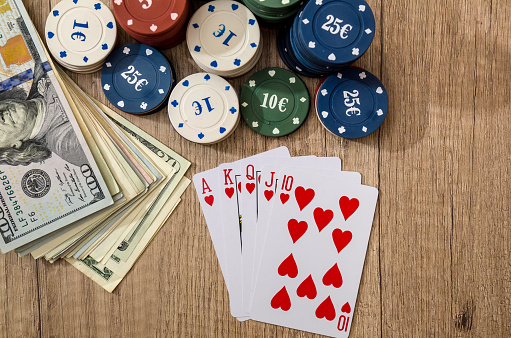Feeling-State Addiction Protocol for Gambling Addiction
 The feeling-state addiction protocol is a modified form of eye movement desensitization and reprocessing, referred to as EMDR in mental health. EMDR is a trauma treatment modality recognized as one of the main treatments for posttraumatic stress (PTSD) and other forms of trauma.
The feeling-state addiction protocol is a modified form of eye movement desensitization and reprocessing, referred to as EMDR in mental health. EMDR is a trauma treatment modality recognized as one of the main treatments for posttraumatic stress (PTSD) and other forms of trauma.
In EMDR therapy, therapists desensitize a traumatic memory by having the person in therapy use eye movements (or other back-and-forth stimulation) while holding the memory in mind along with the feelings, images, and belief about self in that situation. This causes the brain to process the memory in a way that takes the charge off the memory, so it no longer feels disturbing. In feeling-state addiction protocol, we desensitize the pleasant memory causing the addiction by removing the charge from that memory.
Tom and the Feeling-State Theory of Addictions
The feeling-state theory of addictions assumes that the feeling underlying the behavior, not the apparent object or behavior, is the real goal of unwanted compulsive behavior. In alcohol or drug addiction, the substance creates the
“feeling-state” that causes the compulsive behavior. In behavioral addictions, however, any feeling-state can be linked to any behavior. Feeling-states are state-dependent memories created during an intensely experienced event. With gambling addiction, we look for the positive feeling-state linked to the gambling behavior.I worked with a person in therapy, who I will call Tom, who came to me because he had “reached bottom with the consequences of his gambling,” as he put it. Tom is a 37-year-old man who started therapy saying that he wanted to overcome two addictions: a very destructive woman and gambling.
The precipitating incident that brought Tom to therapy was having just lost his last $12,000 in a poker game, the final straw that caused him to lose his house. He had recently moved in with his parents, and they insisted he deal with the gambling addiction.
Both of the addictions Tom wished to treat are known as process addictions or behavioral addictions because they are not addictions to a substance. When he first came to see me, Tom was dealing with an intense sadness from losing his relationship and shame from losing his house and moving in with his parents. Tom’s parents agreed to pay for his therapy and insisted he make measured progress, lest they throw him out of the house.
Although addiction to a person and addiction to gambling seem different, like all behavioral addictions, they both involve an addiction to a feeling-state. According to Dr. Robert Miller, who developed the feeling-state addiction protocol in 2011:
“The feeling-state theory of behavioral and substance addictions postulates that addictions are created when positive feelings become rigidly linked with specific objects or behaviors. This linkage between feelings and behaviors is called a feeling-state. When a feeling-state is triggered, the whole psycho-physiological pattern is activated. The activation of the pattern then triggers the out-of-control behavior.”
The first step in eliminating a compulsion, according to Dr. Miller’s feeling-state protocol, is to figure out the feeling-state that drives the compulsion.
Identifying the Real Addictive Behavior
In therapy, we determined that the feeling-state Tom was addicted to with gambling was bonding with his father, which had provided both a sense of belonging and mastery.
Tom had one brother who was five years older. He described his brother as the favorite and the one his dad often Tom was very shy and described himself as someone who had never excelled at anything. He had few friends and participated in few social activities. In fact, the first time he said he felt any positive attention from his father was when he would watch his father’s poker games every week.praised for his intellectual ability and athletic success. Tom was very shy and described himself as someone who had never excelled at anything. He had few friends and participated in few social activities. In fact, the first time he said he felt any positive attention from his father was when he would watch his father’s poker games every week.
By the age of 18, Tom became a good observer and was playing cards with his dad’s poker group. He was skilled and was often the winner. It was this feeling-state of bonding with his father and the feeling of belonging to a group that drove his gambling compulsion.
We processed these strong feeling-states with EMDR, and his craving for gambling started to subside. We then discovered other feeling-states linked to his gambling. They were the feeling-state of freedom and mastery. Once we unlinked or disconnected these feeling-states with gambling, his desire for gambling waned and we could then address the psychological dynamics underlying the “need” for the gambling, such as his relationship with his dad, his feelings of being a “loser,” and the belief he is not smart and can’t succeed at anything.
We also desensitized his attraction to the destructive woman who had recently come back into his life. When he realized how easy it was to remove that attraction for her, it gave his self-esteem a huge boost. This helped him see other dynamics in his life with more clarity and confidence.
I have used this model with many process addictions, including:
- Shopping addiction
- Shoplifting
- Addiction to a person
- Internet addiction
I find it to be effective and relatively easy for the person in therapy because the person largely avoids the pain of going through withdrawal.
References:
- EMDR International Association. (2014). What is the actual EMDR session like? Retrieved from http://www.emdria.org/?120
- Miller. R. (2011). The feeling-state theory of behavioral and substance addictions and the feeling-state addiction protocol. Retrieved from http://www.psychinnovations.com/EMDRSD/Miller_Feeling_State_Addiction.pdf